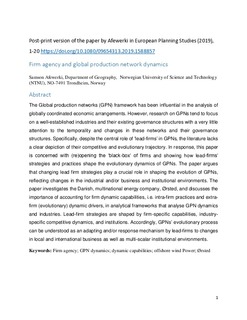| dc.description.abstract | The Global production networks (GPN) framework has been influential in the analysis of globally coordinated economic arrangements. However, research on GPNs tend to focus on a well-established industries and their existing governance structures with a very little attention to the temporality and changes in these networks and their governance structures. Specifically, despite the central role of ‘lead-firms’ in GPNs, the literature lacks a clear depiction of their competitive and evolutionary trajectory. In response, this paper is concerned with (re)opening the ‘black-box’ of firms and showing how lead-firms’ strategies and practices shape the evolutionary dynamics of GPNs. The paper argues that changing lead firm strategies play a crucial role in shaping the evolution of GPNs, reflecting changes in the industrial and/or business and institutional environments. The paper investigates the Danish, multinational energy company, Ørsted, and discusses the importance of accounting for firm dynamic capabilities, i.e. intra-firm practices and extra-firm (evolutionary) dynamic drivers, in analytical frameworks that analyse GPN dynamics and industries. Lead-firm strategies are shaped by firm-specific capabilities, industry-specific competitive dynamics, and institutions. Accordingly, GPNs’ evolutionary process can be understood as an adapting and/or response mechanism by lead-firms to changes in local and international business as well as multi-scalar institutional environments. | nb_NO |
